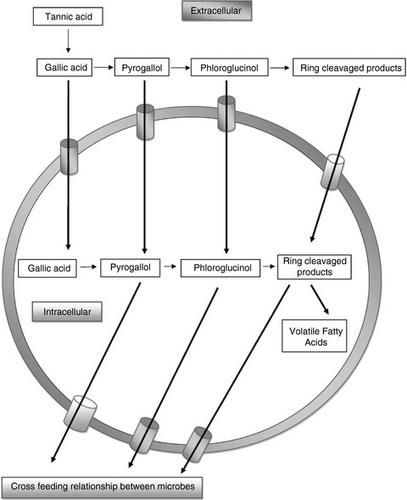当前位置:
X-MOL 学术
›
Lett. Appl. Microbiol.
›
论文详情
Our official English website, www.x-mol.net, welcomes your
feedback! (Note: you will need to create a separate account there.)
A commentary on methodological aspects of hydrolyzable tannins metabolism in ruminant: A perspective view
Letters in Applied Microbiology ( IF 2.0 ) Pub Date : 2020-08-27 , DOI: 10.1111/lam.13346 R Lotfi 1
Letters in Applied Microbiology ( IF 2.0 ) Pub Date : 2020-08-27 , DOI: 10.1111/lam.13346 R Lotfi 1
Affiliation

|
Although, the application of tannic acid (TA), gallic acid (GA), natural hydrolysable tannins (HT)‐rich ingredients, and HT‐rich feeds in ruminant feeding have been explored in order to modify or manipulate microbial activities of digestive tract of animals, the interaction between HT and gastrointestinal microbiota and the fate of HT metabolites (GA, ellagic acid, pyrogallol, resorcinol, phloroglucinol, catechol and urolithin) derived from gastrointestinal microbial HT metabolism in the animal as a whole and animal products are missing. Incomplete biotransformation of HT and TA to GA, pyrogallol, resorcinol, phloroglucinol and other phenolic metabolites is a prevalent phenomenon discovered by researchers who examine the fate of HT metabolites in ruminant. While the rest of fellow researchers do not even examine the fate of HT metabolites and assume the complete biotransformation and fermentation of HT metabolites to volatile fatty acids (VFA). Only three studies have successfully identified the complete biotransformation and fermentation of HT metabolites to VFA in ruminant. The HT metabolites, mostly pyrogallol, produced through incomplete biotransformation of HT have adverse effects on gastrointestinal microbiota and host animal. Lack of awareness regarding the metabolism of HT metabolites and its consequences would compromise ruminant gastrointestinal microbiota, animal welfare, our environment and the power of research papers’ findings. In this perspective paper, I will bring to attention a new angle on the biotransformation and fermentation of HT metabolites in gastrointestinal tract, the role of gastrointestinal microbiota and deficiency of current approach in isolating tannin‐degrading bacteria from rumen. Also, suggestions for better monitoring and understanding HT metabolisms in ruminant are presented.
中文翻译:

反刍动物可水解单宁代谢的方法论评论:透视图
尽管已经探索了单宁酸 (TA)、没食子酸 (GA)、富含天然可水解单宁 (HT) 的成分和富含 HT 的饲料在反刍动物饲养中的应用,以改变或操纵消化道微生物活动。在动物中,HT 和胃肠道微生物群之间的相互作用以及源自整个动物和动物产品的胃肠道微生物 HT 代谢的 HT 代谢物(GA、鞣花酸、连苯三酚、间苯二酚、间苯三酚、儿茶酚和尿石素)的归宿缺失。HT 和 TA 不完全生物转化为 GA、连苯三酚、间苯二酚、间苯三酚和其他酚类代谢物是研究反刍动物 HT 代谢物命运的研究人员发现的普遍现象。而其他研究人员甚至没有检查 HT 代谢物的命运,并假设 HT 代谢物完全生物转化和发酵为挥发性脂肪酸 (VFA)。只有三项研究成功地确定了 HT 代谢物在反刍动物中完全生物转化和发酵为 VFA。通过 HT 的不完全生物转化产生的 HT 代谢物,主要是连苯三酚,对胃肠道微生物群和宿主动物有不利影响。缺乏对 HT 代谢物代谢及其后果的认识会损害反刍动物胃肠道微生物群、动物福利、我们的环境和研究论文结果的力量。在这篇透视论文中,我将从一个新的角度关注 HT 代谢物在胃肠道中的生物转化和发酵,胃肠道微生物群的作用和目前从瘤胃中分离单宁降解细菌的方法的不足。此外,还提出了更好地监测和了解反刍动物 HT 代谢的建议。
更新日期:2020-08-27
中文翻译:

反刍动物可水解单宁代谢的方法论评论:透视图
尽管已经探索了单宁酸 (TA)、没食子酸 (GA)、富含天然可水解单宁 (HT) 的成分和富含 HT 的饲料在反刍动物饲养中的应用,以改变或操纵消化道微生物活动。在动物中,HT 和胃肠道微生物群之间的相互作用以及源自整个动物和动物产品的胃肠道微生物 HT 代谢的 HT 代谢物(GA、鞣花酸、连苯三酚、间苯二酚、间苯三酚、儿茶酚和尿石素)的归宿缺失。HT 和 TA 不完全生物转化为 GA、连苯三酚、间苯二酚、间苯三酚和其他酚类代谢物是研究反刍动物 HT 代谢物命运的研究人员发现的普遍现象。而其他研究人员甚至没有检查 HT 代谢物的命运,并假设 HT 代谢物完全生物转化和发酵为挥发性脂肪酸 (VFA)。只有三项研究成功地确定了 HT 代谢物在反刍动物中完全生物转化和发酵为 VFA。通过 HT 的不完全生物转化产生的 HT 代谢物,主要是连苯三酚,对胃肠道微生物群和宿主动物有不利影响。缺乏对 HT 代谢物代谢及其后果的认识会损害反刍动物胃肠道微生物群、动物福利、我们的环境和研究论文结果的力量。在这篇透视论文中,我将从一个新的角度关注 HT 代谢物在胃肠道中的生物转化和发酵,胃肠道微生物群的作用和目前从瘤胃中分离单宁降解细菌的方法的不足。此外,还提出了更好地监测和了解反刍动物 HT 代谢的建议。











































 京公网安备 11010802027423号
京公网安备 11010802027423号